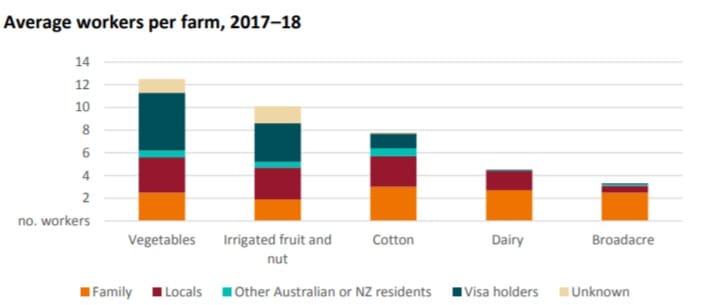AUSTRALIAN citizens dominate the agriculture workforce on broadacre farms, with overseas workers more common on horticultural farms, according to the latest ABARES farm survey.
The ‘Demand for farm workers: ABARES farm survey results 2018’ – released today – found locals were the most commonly employed workers on farms with backpackers dominating the overseas cohort.
ABARES surveyed more than 2400 farms covering broadacre, dairy, vegetable and some irrigation industries.
“Family and other Australian workers make up the majority of the agricultural workforce,” ABARES’ acting executive director Peter Gooday said.
“The dependence on workers living nearby highlights the importance of a pool of local workers to agricultural industries and may reflect limited mobility in the Australian agricultural workforce.”
The survey found that demand for labour on Australian farms has undergone substantial change over the past decade.
The number of owner–managers and contributing family workers on family farms has declined as the number of farms has declined and the average size of farms has increased.
At the same time, the number of employees across the agricultural sector has increased.
Family and other Australian workers make up the majority of the workforce across the industries.
Most of these workers were from the same or a neighbouring district, particularly for full-time and part-time roles.
Broadacre farms were the most dependent on family workers and employed few workers outside the family unit.
The common use of family members across all industries reflects the business structure of farms, with more than 95 per cent of farms in the surveyed industries family owned.
Overseas labour
Overseas workers are also used substantially in the agricultural sector, although make up only a small proportion of workers on broadacre farms.
Many cotton farms use backpackers, but only a small proportion of broadacre farms used workers from overseas.
Nevertheless, because of the large number of broadacre farms, a large number of overseas workers were employed in these industries in aggregate.
Horticultural farms reported the greatest use of labourers; broadacre, dairy and cotton farms engaged more managers and machine operators.
Recruitment challenge
The survey found that rates of recruitment were relatively low for agriculture compared to the rest of the economy.
Low rates in part reflected the dominance of family labour reducing the need to recruit, particularly on dairy and broadacre farms.
However, Mr Gooday said some farmers were having difficulty recruiting and farms in more remote areas had more difficulty recruiting.
Looking ahead, ABARES found that broadacre farms generally expected declines in the number of workers required.
NFF takes survey to task
While the National Farmers Federation (NFF) said the ABARES data relating to the broadacre and dairy industries was consistent with the NFF’s understanding, it disagreed with ABARE’s findings that those industries had significantly more difficulty recruiting workers than vegetable, fruit and nut farms.
NFF chief executive officer Tony Mahar said the NFF found the quantitative ABARES report did not match farmers’ lived experience and failed to provide appropriate or current evidence that would help fix agricultural labour shortages.
“Strangely, this is almost the exact opposite of what NFF members report the situation to be,” he said.
“We have strong reservations about the report as we know the farm labour shortage is most severe in horticulture and while it is still a serious problem, it is less so in the dairy and broadacre sectors.
“The survey doesn’t align with what farmers are saying, did not cover many of the main fruit growing regions and instead focussed on fruit growing in the Murray Darling Basin.
“We are concerned that the findings are unhelpful in providing up-to-date data and positive steps that can be taken to deliver policies and initiatives to widen the farm workforce pool.
“Currently agriculture’s workforce deficit is one of the largest constraints to our sector’s productivity growth and we need solutions for agriculture to reach its potential of being a $100 billion industry by 2030.”
Mr Mahar said the industry-led evidence confirming farmers’ labour challenges was clear.
“A 2019 report commissioned by growers lead by VegetablesWA and developed by Dr Joanna Howe of the University of Adelaide found that 40pc of vegetable growers had been unable to fill vacancies over a five-year period and 22pc said they experienced difficulties attracting workers “almost all of the time”,” he said.
“Alarmingly, Dr Howe confirmed the stark reality that some growers feel they are forced to rely upon ‘undocumented’ migrants who work and remain in Australia, in breach of their visa conditions and to engage in practices which do not comply with Australian labour standards.”
The NFF said its own labour survey found 43pc of farmers experienced labour shortages during peak season, 23pc said they had a constant labour shortage and only 21pc said they never experienced shortages.
The NFF said 20pc of those surveyed estimated losses exceeding $50,000 (and up to more than $2 million) per annum and 30pc of farmers said a shortfall in labour supply was their principle labour concern for the next 12 months (second only to labour costs, at 33pc).
Research carried out by the Victorian Farmers Federation found 67pc of growers in the Sunraysia fruit and vegetable growing region required additional workers.
Mr Mahar said the NFF understood the difficulty of accurately assessing the extent to which farmers, particularly those in intensive industries, had challenges filling jobs.
“The figures are clouded by the mobility of workers, fluctuations between peak and non-peak labour needs, reliance on contractors and labour hire and the prevalence of undocumented workers.
“We also recognise that there are significant difficulties in making generalised findings which cover all farms irrespective of factors such as size, crop, location and turnover.
“To arrive at a complete picture of agriculture’s labour challenges, statistics need to be combined with the unique complexities of actual accounts from farmers.”
Source: ABARES, NFF
‘Demand for farm workers: ABARES farm survey results 2018’ can be found here.




“To arrive at a complete picture of agriculture’s labour challenges, statistics need to be combined with the unique complexities of actual accounts from farmers.”
What an astounding comment from the NFF. ABARES surveyed 2400 farms. Their research is quantitative. This is a fine definition quantitative from Wikipedia : In natural and social sciences, and sometimes in other fields, quantitative research is the systematic empirical investigation of observable phenomena via statistical, mathematical, or computational techniques. The objective of quantitative research is to develop and employ mathematical models, theories, and hypotheses pertaining to phenomena. The process of measurement is central to quantitative research because it provides the fundamental connection between empirical observation and mathematical expression of quantitative relationships.
If the NFF research is also quantitative, somebody has a problem with method and/or interpretation. If the NFF research is qualitative Mr Mahar needs to read the last sentence in the definition.
Mr Mahar claims that solutions need to be found because the labour shortage could prevent agriculture reaching the NFF total of $100 billion at farm gate by 2030. If only that were the only reason.